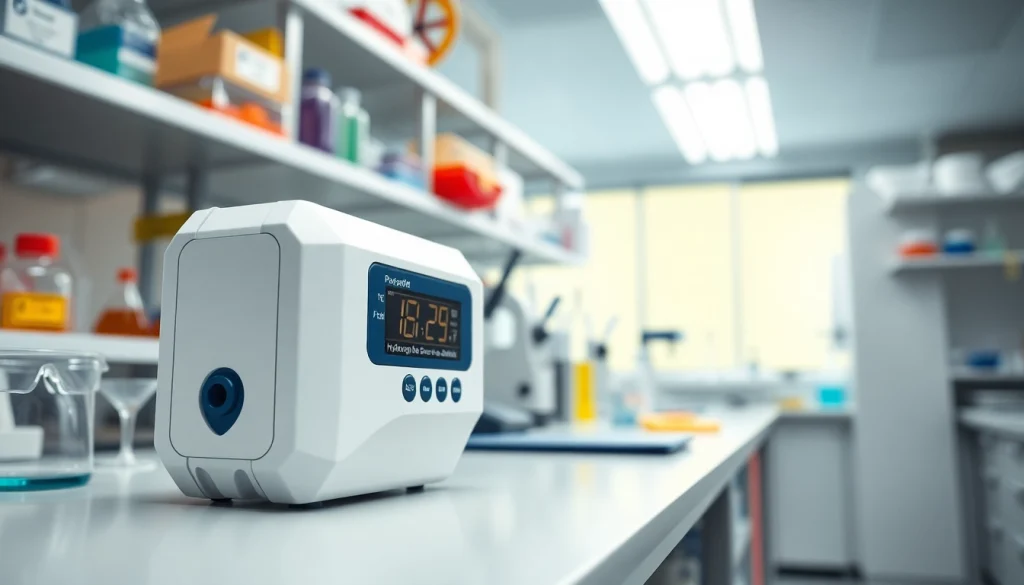Understanding Hydrogen Bromide and Its Risks
What is Hydrogen Bromide?
Hydrogen Bromide (HBr) is a colorless gas with a sharp, acrid odor that is highly corrosive. It is a binary acid composed of hydrogen and bromine and is recognized for its use in chemical synthesis. HBr can also be found in aqueous solutions as hydrobromic acid, which is one of the strongest mineral acids. Due to its reactivity, hydrogen bromide plays a critical role in various industrial processes, including the production of bromine and other organic compounds.
Health Risks Associated with Hydrogen Bromide Exposure
Exposure to hydrogen bromide can lead to severe health effects, making accurate detection crucial in workplaces where it is present. Inhalation of this gas can cause respiratory distress, leading to symptoms such as coughing, wheezing, and difficulty breathing. Prolonged exposure may result in chronic lung issues, and contact with skin or eyes can lead to corrosive burns and irritation. As such, understanding and managing these health risks is essential for ensuring safe working environments, particularly in industries dealing with hazardous substances.
Importance of Accurate Detection
Accurate detection of hydrogen bromide is paramount for workforce safety, regulatory compliance, and emergency preparedness. The challenges of HBr’s volatility and corrosiveness necessitate the use of reliable detection systems. Early detection can significantly reduce the risk of harmful exposure, allowing for prompt evacuation or mitigation measures. Because of this, investing in a quality Hydrogen Bromide detector is a critical step for industrial sites that handle this compound.
Features to Look for in a Hydrogen Bromide Detector
Sensor Technology and Sensitivity
When selecting a hydrogen bromide detector, sensor technology and sensitivity are key factors. Modern detectors typically employ electrochemical or optical sensor technologies for high sensitivity and accuracy. Electrochemical sensors are widely used due to their responsiveness and specificity to HBr, enabling real-time monitoring of gas concentrations. The sensitivity level of the detector, measured in parts per billion (ppb), should meet the regulatory thresholds established by safety standards, ensuring the detector activates well before hazardous levels are reached.
Display and Usability Features
Usability features of hydrogen bromide detectors can greatly affect how quickly and effectively employees can respond to hazardous situations. A clear digital display showing real-time concentration levels, alarm thresholds, and system status is vital for fast analysis. Additional features like audible alarms, vibrating alerts, and visual indicators enhance situational awareness. Intuitive interfaces that facilitate ease of use, even in emergency scenarios, can significantly improve response times and overall safety.
Durability and Maintenance Requirements
Durability is especially important for hydrogen bromide detectors, as they are often used in harsh environments. Look for detectors built with resilient materials that can withstand corrosive atmospheres. Regular maintenance, including calibration and sensor replacement, is essential to ensure optimal detector performance. It’s advisable to choose detectors that provide maintenance alerts and logs, helping users maintain compliance with safety regulations without overwhelming them with manual checks.
Comparison of Top Hydrogen Bromide Detectors
Leading Brands and Their Offerings
The market for hydrogen bromide detectors features several leading brands known for their innovation and reliability. Companies such as Dräger, RKI Instruments, and MSA Safety offer a range of products tailored to specific industrial requirements. For instance, Dräger’s X-am series detects a variety of gases, including HBr, fitting seamlessly into multi-gas detection needs. RKI Instruments’ GX-6000 provides advanced PID detection capabilities for volatile chemicals, which can be essential in preventing HBr exposure.
Price Ranges and Value Analysis
The price of hydrogen bromide detectors can vary widely, typically ranging from a few hundred dollars to several thousand. Budget-friendly options might suffice for smaller operations or low-exposure environments. However, investing in higher-end models often translates into better sensitivity, longer lifespan, and lower total cost of ownership through reduced maintenance and calibration needs. Analyzing these factors is crucial when determining the best fit for specific applications.
User Reviews and Performance Metrics
User feedback provides valuable insights into the performance of hydrogen bromide detectors across different environments. Reviews highlight factors such as detection speed, battery life, and ease of use. Performance metrics, including false alarm rates and calibration frequency, also inform purchasing decisions. It is advisable to consult case studies and industry-specific examples to assess the effectiveness of a detector model under actual working conditions.
Best Practices for Using a Hydrogen Bromide Detector
Installation and Calibration Techniques
Proper installation and calibration are crucial for maximizing the efficacy of hydrogen bromide detectors. Follow the manufacturer’s guidelines for placement, ensuring detectors are situated in areas with the highest risk of gas accumulation. Regular calibration should be performed according to the manufacturer’s recommendations, typically at least once a month, or more frequently in heavily contaminated environments. Users should always log calibration activities for compliance and operational transparency.
Regular Maintenance and Battery Checks
Maintenance plays a vital role in ensuring the longevity and accuracy of hydrogen bromide detectors. Regular checks should include battery assessments, as faulty power sources can lead to detector failures. Replace batteries as per the manufacturer’s specifications, usually once a year or when low battery alerts occur. Visual inspections for physical damage and functionality tests of alarms and displays are also essential parts of a maintenance schedule.
Training Employees for Emergency Situations
Employee training is critical for effective response to hydrogen bromide leaks. Regular safety drills should be conducted, and workers must be trained in the operation of detectors, alarm responses, and evacuation procedures. Additionally, provide educational materials covering the risks associated with hydrogen bromide exposure, enabling staff to make informed decisions during emergencies. Continual reinforcement of safety protocols fosters a culture of safety within the organization.
Future Trends in Hydrogen Bromide Detection Technology
Emerging Innovations in Sensor Technologies
The future of hydrogen bromide detection technology is likely to see significant advancements in sensor innovation. Emerging technologies include nanomaterials and smart sensors, which promise enhanced sensitivity and faster response times. Innovations such as wireless monitoring and the integration of IoT (Internet of Things) capabilities enable real-time data collection and analysis, facilitating proactive safety management. These advancements are expected to make HBr detection more efficient and user-friendly.
Integration with Safety Protocols and Systems
As organizations increasingly prioritize safety and operational efficiency, the integration of hydrogen bromide detectors with broader safety systems is becoming more common. This includes linking detectors to centralized alarm systems, emergency shutdown mechanisms, and environmental monitoring platforms. Such integrations enable a holistic approach to safety, allowing organizations to not only detect hazards but respond immediately to mitigate risks effectively.
Compliance Standards and Regulatory Changes
As regulatory frameworks evolve, compliance regarding hazardous gases like hydrogen bromide is becoming stricter. Key organizations, including OSHA and EPA, continue to revise exposure limits and safety standards, making it critical for companies to stay informed on these changes. Future detectors will likely incorporate compliance features to assist organizations in meeting and exceeding regulatory requirements effortlessly.


